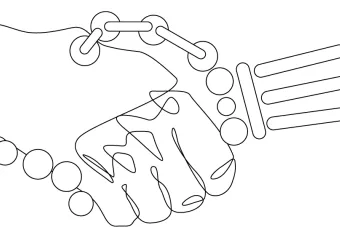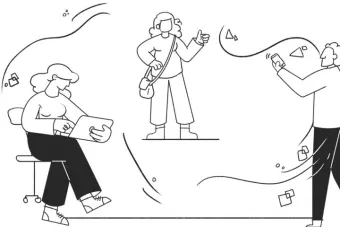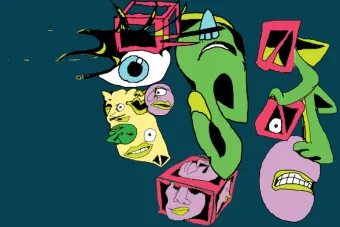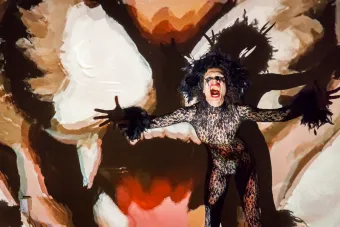2019 Journal of Design and Creative Technologies
Table of Contents

Editor's Note
From Doreen Lorenzo
A welcome message for the Journal of Design and Creative Technologies from Doreen Lorenzo, Associate Dean for the School of Design and Creative Technologies at The University of Texas at Austin.

Exploring Alternative Narratives of Human-Machine Coevolution
By Yuxi Liu, M.F.A.
Traditionally, humans and machines have been painted as opposite ends of the same spectrum. However, with the rise of artificial intelligence, the line between the two is becoming more blurred. The concept of human-machine coevolution inspired a series of 5 experiments that explore the relationship between humans and machines as an equal partnership. This article details each machine's purpose and concludes with the study's findings.

Exploring a UX-Centered AI Design Process for Creating Successful Human and Machine Dialog Interactions
By Ellen Kolstø, M.A. and Jessica Raedler, M.A.
In the age of Siri and Alexa, it's safe to say artificial intelligence (AI) is here to stay. The challenge now lies in designing AI to support successful human-machine interactions that are both complex in nature and simple to use. This paper takes a closer look at one enterprise’s process for changing the way they work to build a thoughtful, user-centered, AI-driven dialog interface system.

Making Work More Meaningful
By Devon Skerritt, Ed.D.
The term "work" can evoke feelings of exhaustion and unfulfillment, but it doesn't have to. This was made clear to a first-generation college graduate whose concept of work was flipped when he began using Life Design tools to reframe the role of work in his life. In this article, the career-counselor-turned-designer details his journey to making work more meaningful for both himself and his students.

The Importance of Importance: Using design thinking to prioritize your personal goals
By Lala Rillera
Design thinking can be used to solve some of the world's most challenging problems, so why not use it to solve your own? When faced with a personal crossroad, an experienced designer pulled from her design tool kit to prioritize her interests through affinity mapping. This article translates her experience into a step-by-step guide for visualizing what matters to you most.

Evolution of a UX Designer
By Veena Sonwalkar
The role of a user experience (UX) designer has changed significantly in recent years. An occupation that once centered on interactions designed independently has shifted toward "designing democratically" for the larger goal of lasting impact. A senior design lead who witnessed this shift firsthand profiles the changing role of today's UX designers and advocates for prioritizing design at every level of an organization.

User Experience in the High Tech Era
By MJ Johns, M.E.T.
Have you ever had a challenging interaction with a product? User experience (UX) has been revolutionized with the advent of technology like the touchscreen smartphone. Good UX design can delight and surprise a user, but bad UX design can get in the way of an experience altogether. In this article, a seasoned game designer discusses the importance of good UX design and some warning signs that a design causes friction for the user.

"Aha" Moments: Innovation of the Past
By RGLR Collective: Daniel Ruszkiewicz, Laura Galos, Maryanne Lee, and Beau Romero
It can be tempting to attribute groundbreaking discoveries as instant, "aha" moments, but RGLR Collective proposes an alternative: Innovation Strategy. Although aha moments are often comfortable and provide instant gratification, innovation strategy intentionally evolves an organization toward a sustainable approach to innovation. This article delves into the purpose and implementation of successful innovation strategy.

Aha Moments: Eliciting Surprises that Improve Experiences
By Jeffrey Bergin, Ph.D.
The element of surprise can fundamentally change the design process. From an initial discovery, to a new idea, to a new insight, surprises are what make us think differently, question assumptions, and delight users. Surprises happen all the time; however, they’re rarely leveraged in ways that genuinely inform the design process. This paper shares six types of surprises that can be cultivated through human-centered design practices, including tips for cultivating and harnessing these surprises.

When Insights Incite: Embracing and Reframing the Insights Designers Discredit, Negate, and Fear
By Stephanie Morgan
In design research, we often assign value to findings based on their novelty, simplicity, and level of surprise. But what if our discoveries are not so surprising? In response to the insights designers have come to discredit, negate, and even fear, a design researcher discusses how we can reframe the complex, time-consuming, and seemingly mundane as opportunities.

Designing for Social Norms
By Warren Schramm
Social norms and expectations govern much of today's workplace. Designers have the unique opportunity to take these social norms into account when creating something new. In this article, one team's experience at design consultancy TEAGUE informed a list of five key considerations to help improve efficiencies and evaluate the impact of social norms in product design.

A Complex Understanding of Compressed Time
By Dax Norman, M.F.A.
Most people have seen or shared a GIF, but have you ever tried creating one? GIFs can be much more than quick video bites to be consumed; they combine time, story, artistry, and, at times, surprise. Read an animation artist's process for creating a 26-image looping sequence that captivates viewers long after its first rotation.

The Responsibility of Design: Adopting a Futures-Oriented Mindset to Support a More Responsible Design Practice
By Adam Zeiner
As global challenges such as climate change and social inequity continue to intensify, the need for long-term thinking in design has never been more critical. Enter design-futures, a discipline that looks ahead to the possible future outcomes of present work. This article examines the need for present-day designers to consider the consequences their designs may produce.

Taking the History: How Medical Students Can Use Design Thinking to Build Deeper Connections with Patients
By the Design Nine: Virginia Waldrop, Katherine Spitz, Taylor Smyth, Dainon Miles, Woody Green, Rachel Fresques, Jacquelyn Callahan, Anatoli Berezovsky, and Francisco Barrios
9 Dell Medical School students (the "Design Nine") assumed they'd learn how to develop empathy with their patients in medical school. However, when they compared their experience as medical students to their work at the Design Institute for Health, they were surprised by their ability to cultivate deeper connections through human-centered design than through traditional clinical interactions. This article explores how future doctors can use the principles of design thinking to provide empathetic care that responds to the needs, behaviors, and values of their patients.

Waller Creek Studio
By Gray Garmon, M.Arch.
During the spring 2019 semester, the Center for Integrated Design pioneered its first capstone course. A team of students from diverse academic backgrounds worked together to improve one of the University of Texas' most unique and overlooked resources: Waller Creek. The results surprised both the students and their instructors. In this article, their lead instructor describes the experience and the outcomes that set the bar high for future capstone projects.

Misread Signs
"Misread Signs" is a multimedia performance by artist and educator Yuliya Lanina featuring animatronic sculptures, projected animation, music, and movement. It explores the effects of trauma on human psyche. The piece transcends the particulars of the artist's experience into a universal story of survival and redemption.
Meet the Team
Editor-in-Chief: Doreen Lorenzo
Managing Editor: Nada Dorman
Article Editors: Katie Fox and Michaela Newman
Explore the 2018 Journal

Take a deep dive into the 2018 issue of the Journal of Design and Creative Technologies.

